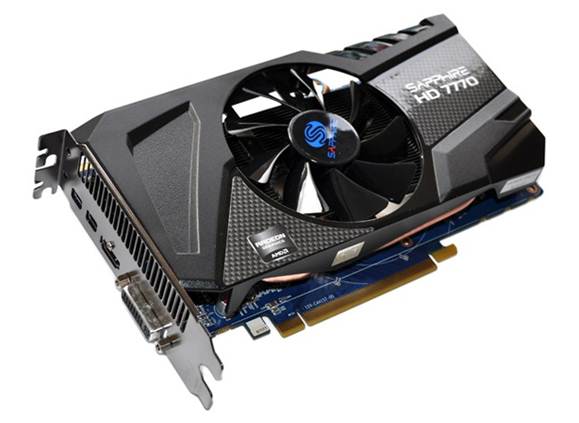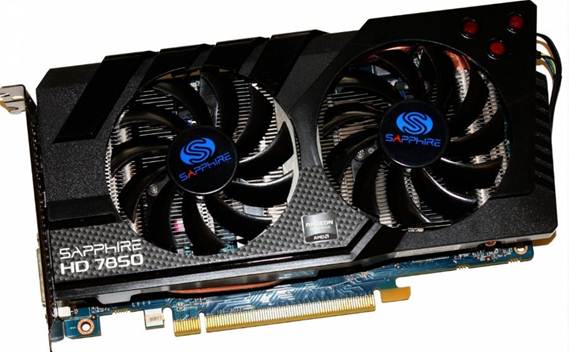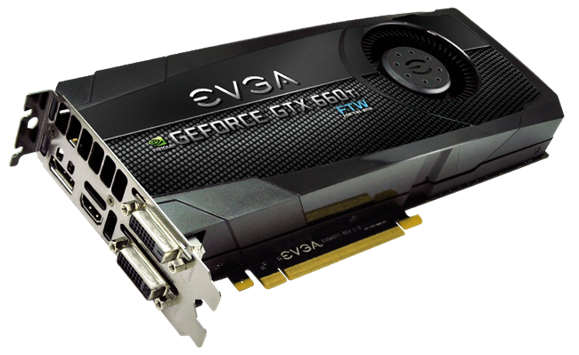Arguably the cheapest card worth recommending
to serious gamers, the Radeon HD 7770 is almost 30% faster than the Radeon HD 7750, but it has steeper requirements; not
only is it double-wide, it also needs its own six-pin power supply That's not
to say it's a power-draining monster (it only uses one six-pin plug, at least),
but you're reaching the point where a budget system would baulk at powering it.
The main problem with this card is that it's
the point where NVidia and AMD start to become more competitive with one another.
There's only a tenner's difference between this and the GeForce GTX 560 SE, but
the latter performs substantially better (around 20% faster under real-world conditions.)

Radeon HD 7770
The average price for the card is $160, putting
it at the absolute bottom of its price range, but if you can find it cheap or absolutely
can't afford more, it's worth considering as a solid performer that can keep up
with modern games. Expect 30fps even in full HD resolution with most details
enabled. Buy it, and you'll be satisfied with the performance, but only if you don't
look at what a few pounds more could have got you.
$160 - $240: GeForce GTX 560
If you're aiming to buy in the $160 - $240
bracket, the NVidia GeForce GTX 560 (note - not the SE or Ti version) is a good
choice. Do be careful, though, because its the specs are all over the place.
This is because no NVidia reference version was produced at launch, meaning
manufacturers were free to clock it however they liked. Its base rate is 810MHz
and the fastest run at speeds of 950MHz, so use that number to inform your
purchase.
Even at the standard speed, this is a
hot-running card and the dual-fans on most versions audibly reflect that. This
is a card for headphone-wearing gamers, there's no doubt about it. Even so,
speeds are high, and the low price makes it worth putting up with its more
irritating qualities.

GeForce
GTX 560
HD performance is good, and ultimately you
won't find better-looking graphics delivered by cheaper cards. Visually it
competes with those that cost a great deal more, because rather than worry
about noise levels, temperature and power consumption (it uses two six-pin
power supplies) they've just packed in the power. If you care more about raw
visuals than micro-managing overall performance, this is the card to go for.
$240 - $320: Radeon HD 7850
The Radeon HD 7850 sits in the $256 - $288
price bracket, and at this point you really start to see how spending money on
a graphics card can improve what you get. Performance at 1920x1200 is nothing
short of excellent, and you can even run in the likes of 2560x1600 if you'll
accept lower detail settings.
In performance terms, it's competing with
the GeForce GTX 560 Ti and the GeForce GTX 570, but it more or less equals
their output at a lower price while taking up less power. If you're feeling
extravagant, benchmarks peg the Radeon FID 7870 (the next card up in the range)
as having roughly 20% better performance, but math’s fans will notice that it's
more than 30% more expensive.

Radeon
HD 7850
Of the available choices. Sapphire perhaps
offer the best deal, coming in below average price even though it's slightly
overclocked all of its FID 7850s out of the box, which is useful if you don't
want to risk doing it yourself. The trade-off is a shorter two-year warranty,
but if you're gaming, two years is long enough to hang onto any card.
$240 - $320: GeForce GTX 660
It’s taken its sweet time getting here, but
the GeForce GTX 660 has finally put a decently powered 6-series GPU on shelves
for under $320. While NVidia’s Kepler cards have been tearing up the high end
of the market, they’ve been out of reach of all but the most dedicated enthusiast
until now. A 2GB card that you can pick up around $288, the GeForce GTX 660
offers fantastic clock speeds starting at 980MHz, with NVidia’s GPU Boost
technology capable of pushing that even higher (cooling permitting).

GeForce
GTX 660
Priced between AMD’s Radeon HD 7850 and
7870, it’s fair to say the card is of comparable power to both - a little
better than the former, a little worse than the latter, but closer to it than
you might expect. Given the lower price, it’s fair to say that the GeForce GTX 660
offers better value, giving you the kind of performance you could expect from a
card costing over $320. We can’t help but recommend it.
The GeForce GTX 660, then, is ideal for
frequent gamers who want the latest compatibility but don’t have unlimited amounts
of money to spend pushing polygons. You can find cards that do more, but none
of them offer such good value.